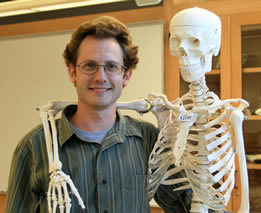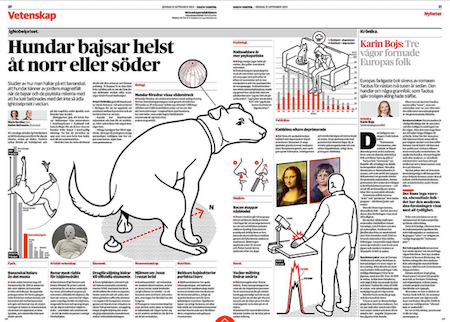Marc Abrahams's Blog, page 375
September 22, 2014
Biological guestimates: Microbes, humans, and ants
Two questions that are easy to answer, unless you care whether the answer is accurate:
1. Is your body mostly microbes? Actually, we have no idea. By Peter Andrey Smith, in the Boston Globe.
2. Are all the ants as heavy as all the humans? By Hannah Moore, for BBC News.

A spirited editorial from The New India Express
Everyone, more or less, loves a spirited editorial. Here’s one, in the September 22, 2014 issue of The New India Express:
Nothing Ignoble About Humour in ScienceResearchers who measured the slipperiness of banana peels, the ability of pork strips to stop nosebleeds and the reactions of reindeer to humans in polar bear suits were among the winners of this year’s Ig Nobel prizes for comical scientific achievements. Two Indian scientists have also won prizes at Ig Nobel awards for their offbeat research work. Dr Sonal Saraiya and her colleagues in Michigan found that packing strips of cured pork in a child’s nasal cavity could stop life-threatening nosebleeds. Naren Ramakrishnan and his colleagues investigated correlations in data on cat bites and depression. The annual prizes, meant to entertain and encourage global research and innovation, are awarded by the Annals of Improbable Research as a whimsical counterpart to the Nobel Prizes which will be announced next month.
Among the 10 awards, four went to researchers that took a peculiar interest in food. The prizes this year also went to researchers who measured the relative pain people suffer while looking at an ugly painting, investigated if cat ownership can be mentally hazardous and studied how people who routinely stay up late can be more psychopathic. Former “real” Nobel winners handed out the spoof awards at Harvard University in Massachusetts.
It will be unwise, however, to laugh at the idiosyncratic pursuits as something that can only be undertaken by researchers who have time on their hands, for it is possible that they can chance upon a valuable scientific discovery. While the differences between dog and cat lovers have long been studied, what hasn’t been is why some people do not like animals at all. This is a trait the animals intuitively understand as the author of Born Free noted in her pet lioness, Elsa. The lioness could even distinguish between those who loved her a great deal and those who loved moderately. Anyone who can successfully probe such secrets can graduate from Ig Nobel to Nobel.

Backstage at the Ig: Miss Sweetie Poo, 2 Greiders, a Maskin, and a Roberts
This fairly candid photo, taken backstage at the 24th First Annual Ig Nobel Prize ceremony, shows Miss Sweetie Poo, backed by (left to right) a Greider, a Maskin, a Greider, and a Roberts. Betsy Devine took the picture:

BONUS: Video highlights of previous Miss Sweetie Poos in action:

September 21, 2014
Hitting-yourself-in-the-head for profit, hypothesized
If you repeatedly bang yourself in the head, with the proper force, in the proper spots, someone will throw money at you. That appears to be the idea explained and (with the exception of the money) demonstrated in this video:
The person hitting herself in the head identifies herself as Erica Awakening. She provides further information of sorts elsewhere. Lawyer’s Weekly identifies her as as Erica Frick, a “Harvard Law School graduate” who in pre-head-banging times “worked for the US Department of Justice and the US attorney’s office in California”.
(Thanks to investigators Neil Martin and NeuroBollocks for bringing this technique to our attention.)

Up the nose: Press reports about the Ig Nobel Prizes
The years bring ever more numerous intriguing, clever press reports and editorials about the Ig Nobel Prize ceremony and the new winners. We’re collecting links to a few of the new ones, on our PRESS CLIPS page.
The Associated Press report include a generous helping of delicious photos, among them Charles Krupa’s instant-classic (it’s appeared on almost countless news and other sites worldwide) photo of the nasal-pork demonstration.

The Reuters report includes Brian Snyder’s photo of that same moment, seen from a different angle, that has achieved about-equal instant-classic status. That pork demonstration pertains to this year’s Ig Nobel Prize for medicine, awarded to Ian Humphreys, Sonal Saraiya, Walter Belenky and James Dworkin, for treating “uncontrollable” nosebleeds, using the method of nasal-packing-with-strips-of-cured-pork.

If you know of other especially whatever news reports that we should add to our PRESS CLIPS list, we’d love to hear from you. Please send the URL(s), of course.
The extensive British and Japanese print, radio, and TV reports are always a treat to see. The Stockholm newspaper Dagens Nyheter always has an especially entertaining and informative account:
The Ig has always been cheerfully chuckled over in Sweden. Googling will turn up many of the other British, Japanese, Swedish, and other reports, if you’d like to indulge yourself. Sweden’s TV4’s report this year includes an interview with Hakan Westerberg, Swedish co-winner of the 2004 Ig Nobel Prize for biology, which honored a surprising discovery about herring.) The science media reports, of course, are a universe packed with delights; you might begin exploring those by reading Bethany Brookshire’s report in Science News: “Banana peel slipperiness wins IgNobel prize in physics“.
[Fun fact: More major news organizations in Hanoi [Vietnam] cover the Ig Nobel Prize ceremony than do news organizations in the Boston [USA] area, where the ceremony has been held for all of its 24 years.]
Here’s our own video recording (from our live webcast) of the entire 2014 Ig Nobel Prize ceremony:
This year, again, we provided a second live video stream: The NSA Courtesy Cam, for benefit of our presumed friends at security agencies around the globe. Here’s the recording of that NSA Courtesy Cam video, which as you’ll see and not hear, had some technical difficulties:
BONUS from the past: The Japanese network NHK’s documentary about the Ig Nobel Prizes, broadcast on Christmas eve in 2002:

Pseudoclarity on whether/how pseudoreplication is a pseudoproblem
Wading into the depths:
“Pseudoreplication is a pseudoproblem,” Jeffrey C. Schank [pictured here], Thomas J. Koehnle, Journal of Comparative Psychology, vol 123(4), Nov 2009, pp. 421-433. The authors explain:
“Pseudoreplication is one of the most influential methodological issues in ecological and animal behavior research today. At its inception, the idea of pseudoreplication highlighted important concerns about the design and analysis of experiments in ecology. The doctrine purported to provide a unified view of experimental design and analysis, wherein precise criteria could be used to assess manuscripts and research proposals for acceptance or rejection. Few methodological doctrines have had as much impact as pseudoreplication, yet there has been very little critical analysis of it. In this paper, the authors extend the growing criticism of the concept of pseudoreplication.”
 Co-author Koehnle says:
Co-author Koehnle says:
“Why bother with any of this stuff? First, there is a basic scientific need to predict and understand how animals learn about what is happening inside their bodies and adjust their behavior to cope. Second, my focus on bodies, brains, and behavior is nested within a concern about intermediate timescales: integrating information over hours to months of experience. This scale of events has been rather neglected in research. Finally, alterations in the anatomy and function of interoceptive brain circuits have been linked to an array of psychiatric disorders in humans, including anxiety, depression, post-traumatic stress disorder, and functional bowel disorders.”

September 20, 2014
The Ig Informal Lectures, today at MIT! You’re invited.
Today the new Ig Nobel Prize winners attempt to explain, if they can, what they did and why they did it. The winners received their prizes Thursday evening, at the 24th First Annual Ig Nobel Prize ceremony.
Come be part of this improbable [definition of "improbable": "not what you expect"] event!
The Ig Informal Lectures
Saturday, Sep 20, 2014 — 1:00 pm
MIT, Building 26, Room 100
 A half-afternoon of improbably funny, informative, informal, brief public lectures and demonstrations:
A half-afternoon of improbably funny, informative, informal, brief public lectures and demonstrations:
The new Ig Nobel Prize winners will attempt to explain what they did, and why they did it
Special appearance by Dr. Yoshiro Nakamats (winner of the 2005 Ig Nobel Prize for Nutrition, and keynote speaker at this year’s Ig Nobel Prize ceremony)
The Ig Nobel Prize winners will be available for you to talk with, both before, during, and after the lectures
The Ig informal Lectures are a free event, organized in cooperation with the MIT Press Bookstore.
Seating is limited, so we suggest you arrive a bit early.
(What happens at the Ig Informal Lectures? Here’s a spectator’s report from last year, 2013.)
Here’s a quick video rundown of some of the new winners, as reported by the ODN network. Below it, a glimpse of the endless array of wonders worked by Dr. Nakamats:

September 19, 2014
What it’s like to be on stage at the Ig Nobel Prize ceremony
What’s it like to be on stage at the Ig Nobel Prize ceremony?
Here’s a visual/aural taste, recorded by Nobel laureate Frank Wilczek, who helped hand out the Ig Nobel Prizes to the winners at last night’s Ig Nobel Prize ceremony:

In re slipping on a banana peel
Bethany Brookshire (aka SciCurious) attended last night’s Ig Nobel Prize ceremony. Her report (in Science News) about the physics prize winner, begins:
Banana peel slipperiness wins IgNobel prize in physics
BOSTON — We’ve all seen the cartoons. Bugs Bunny wolfs down a banana and casually tosses the skin onto the floor. Moments later, Elmer Fudd comes racing in, steps on the banana peel and goes flying. The music plays, and Bugs Bunny wins the day again. That wascally wabbit.
No one has ever really questioned this scenario, though few of us have encountered a banana peel in such a dangerous fashion. It just makes sense that banana peels would be slippery if stepped on. But Kiyoshi Mabuchi and colleagues at Kitasato University in Minato, Japan, were not satisfied with mere legend. They decided to find out just how slick that banana peel really is.
In an awards ceremony at Harvard University on September 18, the researchers received the IgNobel prize in physics for the work. The IgNobels celebrate the truly unusual in science, technology, engineering and math. The studies honored by the prizes often make people laugh. But there’s usually serious science behind the quirky studies.
To determine exactly how slippery a banana peel is, Mabuchi and colleagues sacrificed a total of 12 Cavendish bananas, the iconic yellow banana found on grocery shelves around the world….

Playing with pigs and lasers
Pigs, like humans, can get bored. Perhaps they’d like to play a game to amuse themselves? Even better, with interacting humans? A project designed to examine such possibilities is underway at Hogeschool voor de Kunsten Utrecht and Wageningen University Livestock Research Department in The Netherlands. It’s called ‘Playing With Pigs’ and is “researching the complex relationship between pigs and humans through game design”. The research team decided to experiment with laser-pointers and groups of pigs – making a new discovery :
“During the design process we discovered something that, to our knowledge at the time, animal scientists had not noticed until now: pigs like to play with light. For example, pigs are fascinated by the movement of reflected points of light, and are attracted to new light spots on a surface.”
A website dedicated to playing with pigs is available at www.playingwithpigs.nl
Also see: (Improbable pig-related articles)
‘Pigness’ (Cinematic and Televisual) – a thesis
“Can I have a lick o’ your lollipop?” [Sugar pigs]

Marc Abrahams's Blog
- Marc Abrahams's profile
- 14 followers





